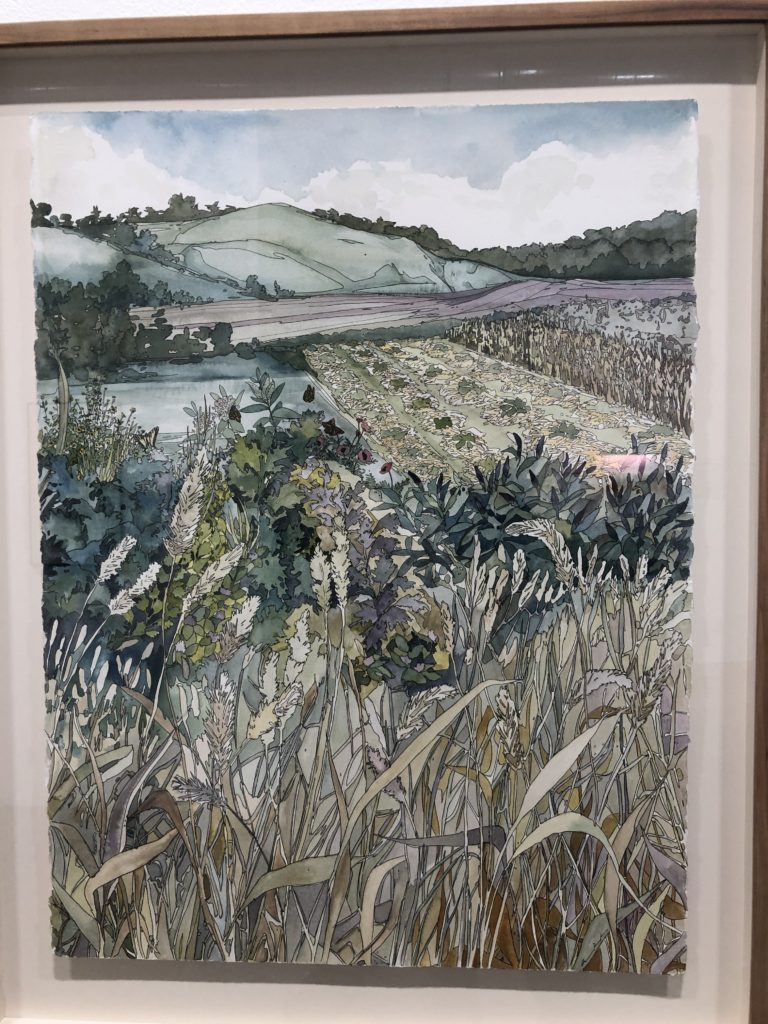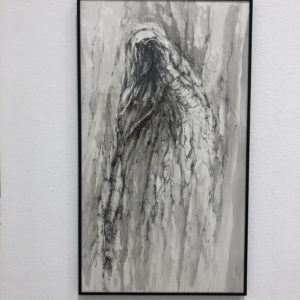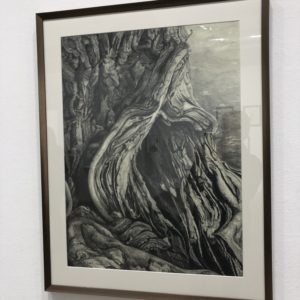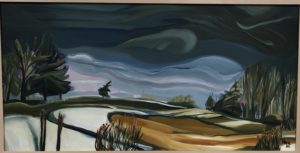Visions of the unbuilt

Andrea Durfee at ROCO
When I was growing up, in both East St. Louis and then in Idaho, my family lived at the edge of undeveloped land. These havens for my imagination weren’t protected, just overlooked or privately owned—undisturbed stretches of wildlife and undergrowth, a mix of grassy slopes, streams, and wooded paths. In a suburb at the edge of East St. Louis, it was a small copse at the base of the hill behind our little Cape Cod, and in Idaho, from our home sitting at the rim of the bench—just above the Boise Valley—I could walk to the edge of our back yard and look down at a fenced pasture with horses and, alongside it, the only human development within a convenient walking distance from the base of the slope, a sawmill. (We had some dangerous forbidden fun bounding across those floating logs.) My friends and my brother and I would spend hours in those spaces, only dimly aware of the smells, the soft feel of the earth, the birds and insects—yet all of it was imprinting itself on my mind whole, planting in me the desire to grow things as an adult and to get outside whenever possible. In those little overlooked tracts of wildness, I felt in touch with myself and the world in a way that I couldn’t in school or inside our home, in front of a television, the only screen that existed back then.
There’s a surplus of artwork on view in Rochester right now devoted, more or less, to the symmetry between human nature and the natural world. (Thou art that, the ancient Hindu philosophers would say.) In a fortunate coincidence, while Oxford Gallery is showing the work of three masterful landscape painters, Rochester Contemporary Art Center has assembled a themed show, Landscapes and the Unbuilt, that celebrates the slightly paradoxical effort that we human beings are making to keep from spoiling places like the ones that helped shape me as a kid. We’re intervening to prevent ourselves from, well, intervening. For the RoCo show, a group of artists took as their subject a particular parcel of land under the protection of the Genesee Land Trust, and they created one or more works to capture the spirit of the place. The work is all marvelous, especially grouped together in a way that amplifies each individual effort—and some of it represents the best work I’ve yet seen from these particular artists. The terms of the show may have brought out new dimensions in their work by forcing some of them to pay attention to the particulars of a specific place.
I responded most intensely to what I saw just inside the entrance to the East Avenue membership gallery. There’s an intricacy and density in Andrea Durfee’s paintings and Bill Stephens’s drawings that makes it hard to get any deeper into the exhibition, there’s so much to see in just one or two of these pieces up front. In the work of both, the task of having to convey an actual, particular place—to sift through myriad impressions of a specific location and nurture a companionship with that landscape—produced excellent results. I’ve always liked Durfee’s work, but the clarity and particularity of her vision is amazing in her three largest paintings of Full Lotus Farm in Arcadia, NY. It feels like a new benchmark for her. She uses flat areas of color outlined with spiderweb-thin lines, vaguely reminiscent of stained glass. Her technique echoes the outlines of cloisonnism and some of the Nabis, yet her paintings have a different effect on the viewer—they draw you deep into the scene she depicts, forgetful of the painted surface, though they aren’t conventionally realistic. In each one, she conceals a nude female figure—her avatar, maybe—merged with the landscape yet emerging like bedrock pushed up from beneath permafrost.
Each of these images could serve as an emblem of the show’s purpose, to emphasize the symbiotic unity between nature and its most conflicted creature. Yet here, these elements of her style efface themselves behind the vibrant light and the scene’s immediacy. You feel the sun on your face and hear the cicadas. The surfeit of detail in the foreground of her recent paintings somehow unifies itself into an effect like the energy of a summer day. The most impressive painting in her grouping, Through the Garden, depicts receding tiers of vegetation, layers of growth that stand at successive distances behind a frieze of wild grasses in the foreground done with assiduous draftsmanship. These swaying stems are backed by more and more distant strata, with the female nude so unobtrusively camouflaged beyond a road as an irregular bulge of earth that I missed it at first and wondered if Durfee had given up on the trope. In these pieces, it works perfectly and underscores the point of the show: how hard it is to draw a border between human nature and the world it reflects.
 Directly across from her work are some of the largest drawings I’ve seen from Bill Stephens—and the surprise is that somehow the larger scale seems to have spurred him to find even more dense levels of entrancing detail, smaller regions of fascination within larger forms that emerge under his pen. In his methods, Stephens is has essentially been a surrealist, surrendering to process, letting the image emerge on its own as he works instinctively from his first marks. Yet here he’s taking pains to capture particulars of what he saw at Gosnell Big Woods Preserve in Webster. The results are dramatic and some of the work reminds me of Barry Moser’s illustrations of the dark wood introduced at the opening of The Divine Comedy. These drawings feel like work done from a deep sense of confidence and purpose, in a way the sort of images he’s been working toward over the past few years, and the marvel is how much he finds to see and show in ink drawings that conjure up psychological depths from a few gnarled roots or frond-like leaves. As in Durfee’s paintings, there’s a fine balance between complexity of detail and overall unity—how the unity is achieved represents part of what fascinates. In my favorite piece, Big Woods Spirit, what appears to be a twisted tree trunk, in literal terms, morphs into a hooded figure, like a ranger from Lord of the Rings or maybe a hint of Donatello’s prophet, some visionary wandering in from a long stay in the wilderness, impossible to ignore or dismiss. I think I wouldn’t want to turn my back on this particular tree—out of respect and maybe caution—and then I remember I’m looking at something akin to driftwood. It doesn’t diminish the respect.
Directly across from her work are some of the largest drawings I’ve seen from Bill Stephens—and the surprise is that somehow the larger scale seems to have spurred him to find even more dense levels of entrancing detail, smaller regions of fascination within larger forms that emerge under his pen. In his methods, Stephens is has essentially been a surrealist, surrendering to process, letting the image emerge on its own as he works instinctively from his first marks. Yet here he’s taking pains to capture particulars of what he saw at Gosnell Big Woods Preserve in Webster. The results are dramatic and some of the work reminds me of Barry Moser’s illustrations of the dark wood introduced at the opening of The Divine Comedy. These drawings feel like work done from a deep sense of confidence and purpose, in a way the sort of images he’s been working toward over the past few years, and the marvel is how much he finds to see and show in ink drawings that conjure up psychological depths from a few gnarled roots or frond-like leaves. As in Durfee’s paintings, there’s a fine balance between complexity of detail and overall unity—how the unity is achieved represents part of what fascinates. In my favorite piece, Big Woods Spirit, what appears to be a twisted tree trunk, in literal terms, morphs into a hooded figure, like a ranger from Lord of the Rings or maybe a hint of Donatello’s prophet, some visionary wandering in from a long stay in the wilderness, impossible to ignore or dismiss. I think I wouldn’t want to turn my back on this particular tree—out of respect and maybe caution—and then I remember I’m looking at something akin to driftwood. It doesn’t diminish the respect.
Jean Stephens brings a similar kind of intensity—with a more traditional emphasis on building form from areas of value rather than with her husband’s storm of etching-fine lines—in her graphite  drawings from Ganargua Creek Meadow Preserve. In a poem she wrote about the project, on display with the work, she refers to the trees and vegetation as “these old gals” and her imagery evokes an anthropomorphic likeness to human form in vegetation and the earth—but, as with Durfee, the vegetative world reveals itself to Stephens as distinctly female. It’s a cosmic yin to the yang of human technology and artifice. Portal shows an ancient-looking trunk where it spreads out into exposed roots as a door between inner and outer, a gnarly portal that might be a feminist nod more toward Georgia O’Keefe than Judy Chicago. These anatomical overtures speak more about nature’s generative power than gender politics.
drawings from Ganargua Creek Meadow Preserve. In a poem she wrote about the project, on display with the work, she refers to the trees and vegetation as “these old gals” and her imagery evokes an anthropomorphic likeness to human form in vegetation and the earth—but, as with Durfee, the vegetative world reveals itself to Stephens as distinctly female. It’s a cosmic yin to the yang of human technology and artifice. Portal shows an ancient-looking trunk where it spreads out into exposed roots as a door between inner and outer, a gnarly portal that might be a feminist nod more toward Georgia O’Keefe than Judy Chicago. These anatomical overtures speak more about nature’s generative power than gender politics.
Even though Phyllis Bryce Ely has been exhibiting a lot over the past year—at Main Street Arts and Oxford—she doesn’t appear to be stretching herself thin. This show, on the heels of the others, gives you maybe the clearest way to see the full scope of her work, from oil to encaustic. Some of the small paintings in wax serve as simple, iconic distillations of what she saw at Cornwall Preserve in Williamson, NY. Yet her most characteristic strengths are in her larger oils. The swirls of sky and land almost seem emblems of altered states: psychotropic visions of a natural order. If Edvard Munch had been a much happier camper, he might have painted scenes like this.
 She was paying a visit to the exhibition when Bill Santelli and I arrived to see the show, and she explained that the artists all had about two months during which to do the work, a very tight opportunity, and she hadn’t gotten to know her paintings much before delivering them to RoCo. “I feel a little exposed,” she said. One of the interesting features in several of the paintings: she did them on discarded engineering vellums, from the planning office where she works in Penfield. Developers bring them in and if something turns out to be unacceptable in a particular schematic, they toss out the drawing and bring back a revised one. She collects these discards and uses them as a support, with a palimpsest of lines and words showing through layers of paint. In some cases, the drawings resonate or contrast with the image she applies to them.
She was paying a visit to the exhibition when Bill Santelli and I arrived to see the show, and she explained that the artists all had about two months during which to do the work, a very tight opportunity, and she hadn’t gotten to know her paintings much before delivering them to RoCo. “I feel a little exposed,” she said. One of the interesting features in several of the paintings: she did them on discarded engineering vellums, from the planning office where she works in Penfield. Developers bring them in and if something turns out to be unacceptable in a particular schematic, they toss out the drawing and bring back a revised one. She collects these discards and uses them as a support, with a palimpsest of lines and words showing through layers of paint. In some cases, the drawings resonate or contrast with the image she applies to them.
I can’t do justice to all the work in the show, though it’s all fascinating and beautifully presented. Jennifer Schinzing’s glass boxes laden with beautiful, lapidary glass sculpture serve as beds for small taxidermied animals: bunnies, birds, and squirrels. It sounds macabre, but the effect is entirely the opposite: the small animals look asleep. The work is serene and almost radiant, qualities virtually impossible to capture in a photograph. (I know; I tried.) Nate Hodge, who has done murals throughout the region, produced a single painting, with an assembly of collateral objects linked to the site he depicts and his interaction with it, including a pair of muddy boots. The parameters of the show: to produce work that conveys a relationship with one particular place seems to have focused and concentrated his talent–as if may have done with Durfee and Stephens–in a way that makes the painting much more intricate and concentrated than his expansive murals. The work is a soaring abstract evoking a forested scene under a brilliant sky, though nothing is rendered in conventional ways. It’s assured and exuberant, spontaneous but disciplined. It feels as if he’s worked hard to be true to something outside his imagination. The outcome is exhilarating.
Comments are currently closed.